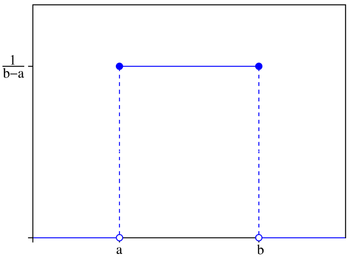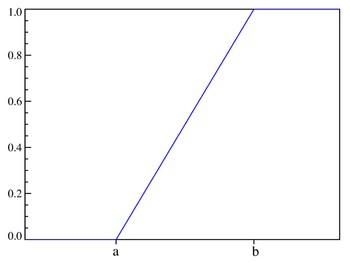- Uniform distribution (continuous)
-
Uniform Probability density function

Using maximum conventionCumulative distribution function

notation: 
parameters: 
support: ![x \in [a,b]](9/8290bddba5acf9822dcbf61f4ac67d1b.png)
pdf: ![\begin{cases}
\frac{1}{b - a} & \text{for } x \in [a,b] \\
0 & \text{otherwise}
\end{cases}](5/fb58762fb8e4aac0baa635ca7c01e65e.png)
cdf: ![\begin{cases}
0 & \text{for } x \le a \\
\frac{x-a}{b-a} & \text{for } x \in [a,b] \\
1 & \text{for } x \ge b
\end{cases}](4/5d4d74273bca95256fa860612db73c3d.png)
mean: 
median: 
mode: any value in [a,b] variance: 
skewness: 0 ex.kurtosis: 
entropy: 
mgf: 
cf: 
In probability theory and statistics, the continuous uniform distribution or rectangular distribution is a family of probability distributions such that for each member of the family, all intervals of the same length on the distribution's support are equally probable. The support is defined by the two parameters, a and b, which are its minimum and maximum values. The distribution is often abbreviated U(a,b). It is the maximum entropy probability distribution for a random variate X under no constraint other than that it is contained in the distribution's support.[1]
Contents
Characterization
Probability density function
The probability density function of the continuous uniform distribution is:
The values of f(x) at the two boundaries a and b are usually unimportant because they do not alter the values of the integrals of f(x) dx over any interval, nor of x f(x) dx or any higher moment. Sometimes they are chosen to be zero, and sometimes chosen to be 1/(b − a). The latter is appropriate in the context of estimation by the method of maximum likelihood. In the context of Fourier analysis, one may take the value of f(a) or f(b) to be 1/(2(b − a)), since then the inverse transform of many integral transforms of this uniform function will yield back the function itself, rather than a function which is equal "almost everywhere", i.e. except on a set of points with zero measure. Also, it is consistent with the sign function which has no such ambiguity.
In terms of mean μ and variance σ2, the probability density may be written as:
Cumulative distribution function
The cumulative distribution function is:
Its inverse is:
In mean and variance notation, the cumulative distribution function is:
and the inverse is:
Generating functions
Moment-generating function
The moment-generating function is
from which we may calculate the raw moments m k
For a random variable following this distribution, the expected value is then m1 = (a + b)/2 and the variance is m2 − m12 = (b − a)2/12.
Cumulant-generating function
For n ≥ 2, the nth cumulant of the uniform distribution on the interval [0, 1] is bn/n, where bn is the nth Bernoulli number.
Properties
Generalization to Borel sets
This distribution can be generalized to more complicated sets than intervals. If S is a Borel set of positive, finite measure, the uniform probability distribution on S can be specified by defining the pdf to be zero outside S and constantly equal to 1/K on S, where K is the Lebesgue measure of S.
Order statistics
Let X1, ..., Xn be an i.i.d. sample from U(0,1). Let X(k) be the kth order statistic from this sample. Then the probability distribution of X(k) is a Beta distribution with parameters k and n − k + 1. The expected value is
This fact is useful when making Q-Q plots.
The variances are
Uniformity
The probability that a uniformly distributed random variable falls within any interval of fixed length is independent of the location of the interval itself (but it is dependent on the interval size), so long as the interval is contained in the distribution's support.
To see this, if X ~ U(a,b) and [x, x+d] is a subinterval of [a,b] with fixed d > 0, then
which is independent of x. This fact motivates the distribution's name.
Standard uniform
Restricting a = 0 and b = 1, the resulting distribution U(0,1) is called a standard uniform distribution.
One interesting property of the standard uniform distribution is that if u1 has a standard uniform distribution, then so does 1-u1. This property can be used for generating antithetic variates, among other things.
Related distributions
- If X has a standard uniform distribution, then by the inverse transform sampling method, Y = − ln(X) / λ has an exponential distribution with (rate) parameter λ.
- Y = 1 − X1/n has a beta distribution with parameters 1 and n. (Note this implies that the standard uniform distribution is a special case of the beta distribution, with parameters 1 and 1.)
- The Irwin–Hall distribution is the sum of n i.i.d. U(0,1) distributions.
- The sum of two independent, equally distributed, uniform distributions yields a symmetric triangular distribution.
Relationship to other functions
As long as the same conventions are followed at the transition points, the probability density function may also be expressed in terms of the Heaviside step function:
or in terms of the rectangle function
There is no ambiguity at the transition point of the sign function. Using the half-maximum convention at the transition points, the uniform distribution may be expressed in terms of the sign function as:
Applications
In statistics, when a p-value is used as a test statistic for a simple null hypothesis, and the distribution of the test statistic is continuous, then the p-value is uniformly distributed between 0 and 1 if the null hypothesis is true.
Sampling from a uniform distribution
There are many applications in which it is useful to run simulation experiments. Many programming languages have the ability to generate pseudo-random numbers which are effectively distributed according to the standard uniform distribution.
If u is a value sampled from the standard uniform distribution, then the value a + (b − a)u follows the uniform distribution parametrised by a and b, as described above.
Sampling from an arbitrary distribution
Main article: Inverse transform samplingThe uniform distribution is useful for sampling from arbitrary distributions. A general method is the inverse transform sampling method, which uses the cumulative distribution function (CDF) of the target random variable. This method is very useful in theoretical work. Since simulations using this method require inverting the CDF of the target variable, alternative methods have been devised for the cases where the cdf is not known in closed form. One such method is rejection sampling.
The normal distribution is an important example where the inverse transform method is not efficient. However, there is an exact method, the Box–Muller transformation, which uses the inverse transform to convert two independent uniform random variables into two independent normally distributed random variables.
Estimation
Estimation of maximum
Main article: German tank problemGiven a uniform distribution on [0, N] with unknown N, the UMVU estimator for the maximum is given by
where m is the sample maximum and k is the sample size, sampling without replacement (though this distinction almost surely makes no difference for a continuous distribution). This follows for the same reasons as estimation for the discrete distribution, and can be seen as a very simple case of maximum spacing estimation. This problem is commonly known as the German tank problem, due to application of maximum estimation to estimates of German tank production during World War II.
Estimation of midpoint
The midpoint of the distribution (a + b) / 2 is both the mean and the median of the uniform distribution. Although both the sample mean and the sample median are unbiased estimators of the midpoint, neither is as efficient as the sample mid-range, i.e. the arithmetic mean of the sample maximum and the sample minimum, which is the UMVU estimator of the midpoint (and also the maximum likelihood estimate).
See also
- Beta distribution
- Box–Muller transform
- Probability plot
- Q-Q plot
- Random number
- Rectangular function
- Uniform distribution (discrete)
References
- ^ Park, Sung Y.; Bera, Anil K. (2009). "Maximum entropy autoregressive conditional heteroskedasticity model". Journal of Econometrics (Elsevier): 219–230. http://www.wise.xmu.edu.cn/Master/Download/..%5C..%5CUploadFiles%5Cpaper-masterdownload%5C2009519932327055475115776.pdf. Retrieved 2011-06-02.
External links
Some common univariate probability distributions Continuous beta • Cauchy • chi-squared • exponential • F • gamma • Laplace • log-normal • normal • Pareto • Student's t • uniform • WeibullDiscrete List of probability distributions Categories:- Continuous distributions
Wikimedia Foundation. 2010.

![f(x)=\begin{cases}
\frac{1}{b - a} & \mathrm{for}\ a \le x \le b, \\[8pt]
0 & \mathrm{for}\ x<a\ \mathrm{or}\ x>b
\end{cases}](b/8fbfebfbb3dfa135da807a45374376d5.png)

![F(x)= \begin{cases}
0 & \text{for }x < a \\[8pt]
\frac{x-a}{b-a} & \text{for }a \le x < b \\[8pt]
1 & \text{for }x \ge b
\end{cases}](d/54d9c1cbcb739aeaca46aee3313ca2bb.png)









![P\left(X\in\left [ x,x+d \right ]\right)
= \int_{x}^{x+d} \frac{\mathrm{d}y}{b-a}\,
= \frac{d}{b-a} \,\!](6/706f126a636a3d3f242cdcfc6e8478aa.png)



